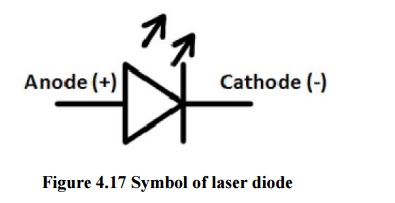Chapter: Electronic Devices : Special Semiconductor Devices
Laser Diode
LASER DIODE
Laser
action (with the resultant monochromatic and coherent light output) can be
achieved in a p-n junction formed by two doped gallium arsenide layers. The two
ends of the structure need to be optically flat and parallel with one end
mirrored and one partially reflective. The length of the junction must be
precisely related to the wavelength of the light to be emitted. The junction is
forward biased and the recombination process produces light as in the LED (incoherent).
Above a certain current threshold the photons moving parallel to the junction
can stimulate emission and initiate laser action.
Laser
diodes and light emitting diodes have a number of elements in common with
respect to their theory of operation. However the laser diode theory of
operation incorporates more elements, taking in additional processes to provide
the coherent light it produces.
Symbol

Figure 4.17 Symbol of laser diode
Structure and characteristic curve

Figure 4.18 (a) Struct ure and (b) characteristic
curve of laser di ode
A laser diode, or LD, is an electrically pumped
semiconductor l aser in which the active medium is formed by a p-n j unction of
a semiconductor diode similar to that found in a emitting diode. The laser
diode is the most common type of laser produced. Laser diodes have a very wide
range of uses that include, but are not limited to, fibre optic communic
ations, barcode readers, laser pointers, CD/DVD/Blu-ray reading, laser
printing, scanning and increasingly directional lighting sources.
Laser diode theory basics
There are
three main processes in semiconductors that are associated with light:
·
Light
absorption: Absorption
occurs when light enters a semiconductor and its energy is
transferred
to the semiconductor to generate additional free electron s and holes. This
effect is widely used and enables devices like to photo-detectors and solar
cells to operate.
Spontaneous emission : The second
effect known as spontaneous emission occurs in LEDs. The light produced in this manner is what is termed
incoherent. In other words the frequency and phase are random, although the
light is situated in a given part of the spectrum.
·
Stimulated
emission: Stimulated emission is different. A light photon entering the semiconductor lattice w ill strike an
electron and release energy in t he form of another light photon. The way in
which this occurs releases this new photon of i dentical wavelength and phase.
In this way the liight that is generated is said to be coherent.
The key
to the laser diode operation occurs at the junction of the highly doped p and n
type regions. In a normal p-n junction curre nt flows across the p-n junction.
This action can occur because the holes from the p-type region and the
electrons from the n-type region combine. With an electromagnetic wave (in this
instance light) in passing through the las er diode junction diode junction it
is found that the photo-emission process occurs. Here the photons release
further photons of light occurs when they strike electrons during the
recombination of holes and electrons occurs.
Naturally
there is some absorpttion of the light, resulting in the generation o f holes
and electrons but there is an overall gain in level.
The
structure of the laser diode creates an optical cavity in which the light
photons have multiple reflections. When the photons are generated only a small
number are abl e to leave the cavity. In this way when one photon strikes an
electron and enables another photon to be generated the process repeats itself
and the photon density or light level starts to build u p. It is in the design
of better optical cavities that much of the current work on lasers is being u
ndertaken. Ensuring the light is properly reflected is the key to the operation
of the device.
Related Topics